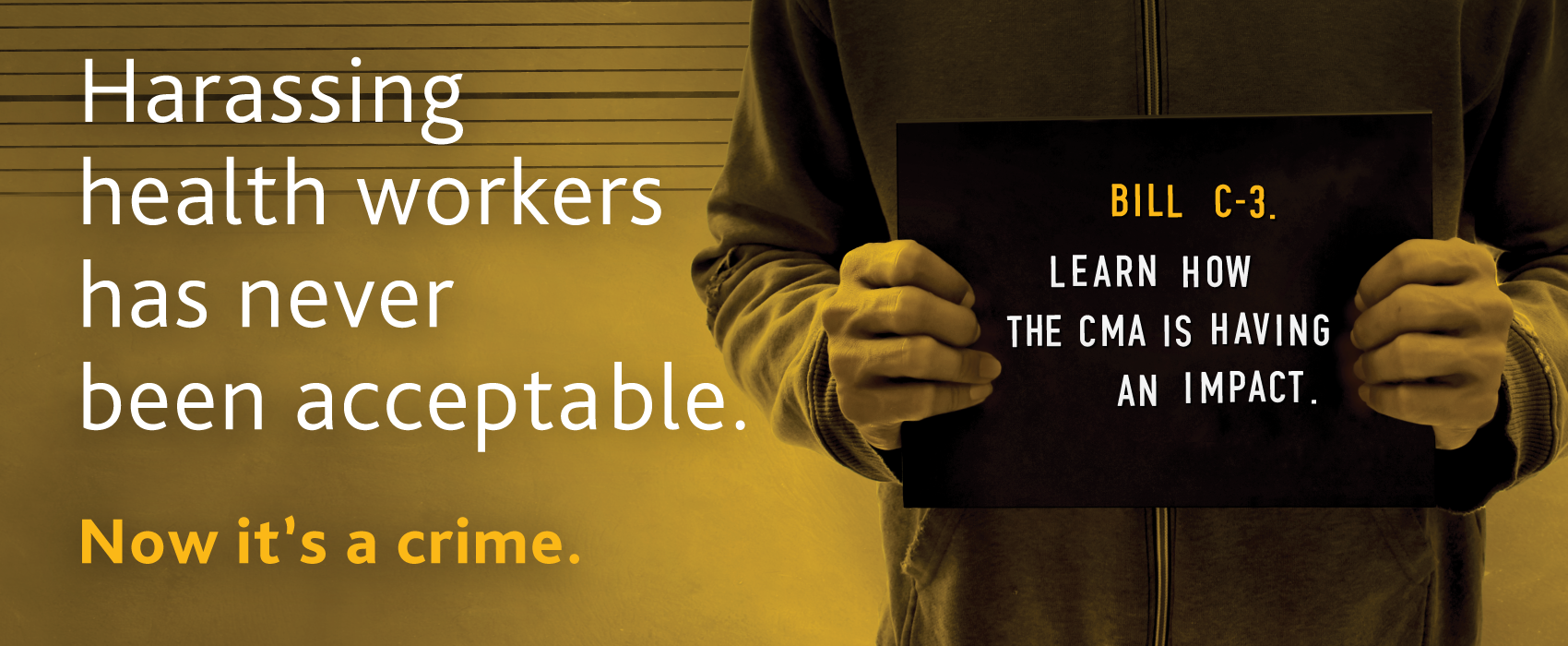Last updated: Jan. 12, 2023
Don’t wear your scrubs to work.
That was the message health professionals received as some protests against COVID-19 restrictions, staged right outside clinics and hospitals, persisted for weeks at a time through the winter of 2022.
Health care workers were subjected to abuse on the job before the pandemic. But threats have escalated. In addition to walking through throngs of angry protestors to get to work, physicians have been the targets — both in person and online —of misogynistic and racist bullying, stalking, even death threats.
Dr. Don Klassen, a family physician in rural Manitoba, says it’s the worst treatment of health care workers he’s seen in 40 years of practice. “[It’s] the first time I’ve had it suggested to me that somebody would put a gun to my head,” he told the Winnipeg Free Press.
In November 2021, the Canadian Medical Association (CMA) called for urgent federal legislation to protect workers from such bullying and harassment – part of our commitment to physicians’ physical, psychological and cultural safety.
The result was Bill C-3 — An Act to amend the Criminal Code and the Canada Labour Code.
Since the act took effect Jan. 16, 2022, charges of intimidating a health worker have been laid. But as accounts of threats, harassment and abuse on the job persist, awareness and enforcement of the law remain critically important. Read the CMA’s statement.
Learn more about how the CMA is having an impact
Our FocusHow common is it for physicians to experience harassment?
The results from the CMA’s 2021 National Physician Health Survey found that eight in 10 physicians — you read that right — have experienced intimidation, bullying, harassment and/or microaggressions in the workplace at some point in their careers.
Four in 10 physicians reported that these experiences happen “frequently” or “often,” with women significantly more likely to say they happen at least once a week.
And abuse follows doctors beyond the physical workplace. According to a recent survey published by JAMA Internal Medicine, nearly one-quarter of respondents reported being personally attacked on social media in 2019. Here, too, a disproportionate number of women reported being targets of harassment.
For all targets, the impact was significant: those who experienced consistent harassment reported emotional distress and fear.

Weren't there already anti-bullying laws?
Physicians are protected by the same legislation as everyone else, meaning they can report harassment, intimidation and threats to the police. But some doctors argued a bigger shield was needed. As Toronto physician Dr. Naheed Dosani told CBC News:
When our governments make policy choices that don’t stand with the science and health workers, they leave us vulnerable with no cover, with targets on our backs. It’s like the Wild, Wild West out here — we are on our own.
How is Bill C-3 making a difference for physicians?
Bill C-3 outlines enhanced protections for health care workers under Canada’s Criminal Code including two new offences:
- It is illegal to use fear to stop a health care worker or those who assist them from performing their duties, or to prevent a person from obtaining health services.
- It is illegal to obstruct any person from accessing health facilities.
Those convicted of these offences could face up to 10 years in prison. The legislation also states that offences targeting health workers can be used as aggravating factors during sentencing.
What else can be done to protect health care workers from harassment?
There is strong public support for targets of aggression on social media. When the owner of a right-wing media outlet offered a “$5,000 bounty” for any video footage of Dr. Dosani breaking COVID-19 protocols, Twitter exploded with #IStandWithDrDosani posts. Although some aggressive posts have been removed, there are calls for expanded action from companies like Twitter to protect the health advocates and experts providing vital expertise — for free — to their users. The federal government has also committed to establishing a transparent and accountable regulatory framework for online safety in Canada.
What else is the CMA doing to promote physician’s physical, psychological and cultural safety?
The CMA is working towards a national framework for physician safety to foster better access, incentivization and accountability for doctors’ physical, psychological and cultural wellbeing.
Our goal: a thriving workforce that supports physicians as people as well as professionals, and a medical culture that elevates diversity and inclusion.
The CMA also provides resources for individuals and teams through our Physician Wellness Hub. And trained facilitators lead peer discussions on topics from psychological first aid to mindful parenting on our Wellness Connection platform, a virtual safe space for learners and physicians.
